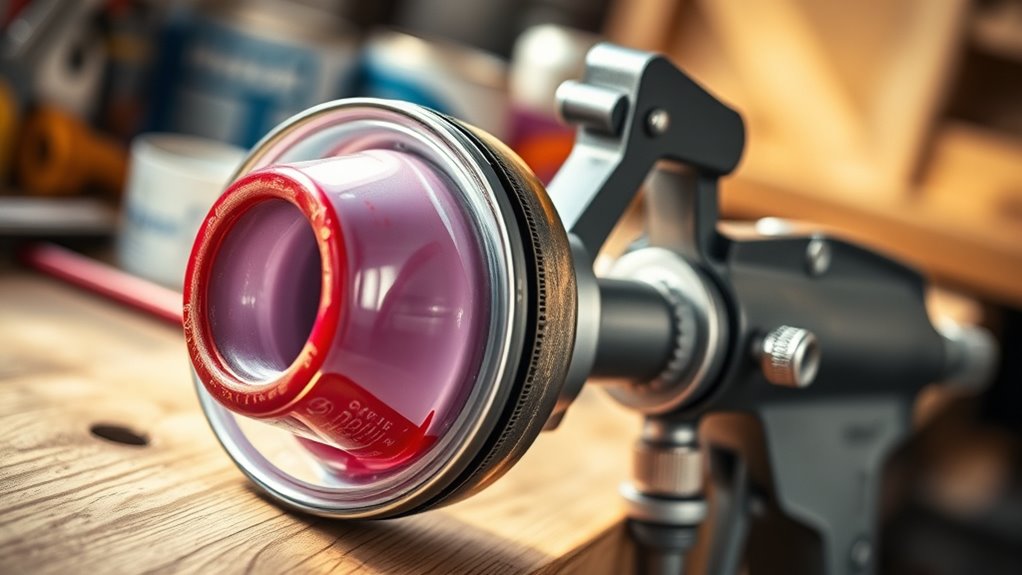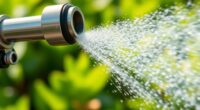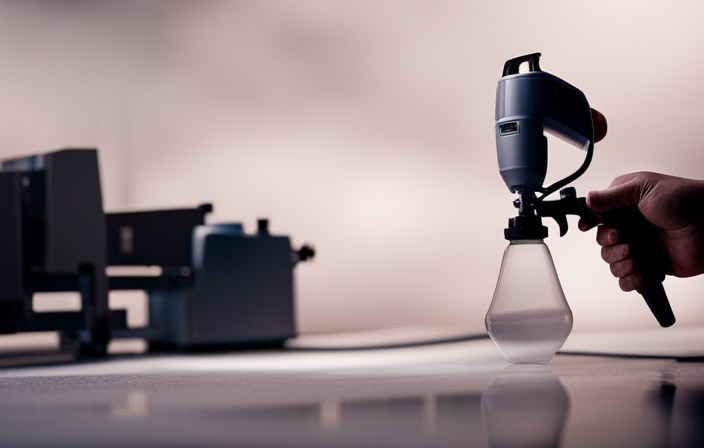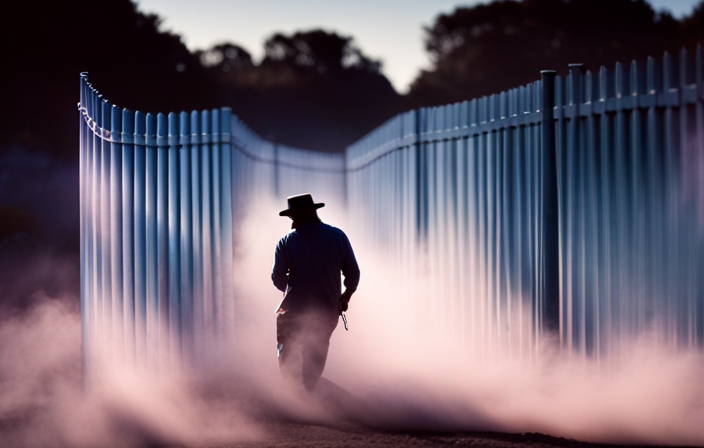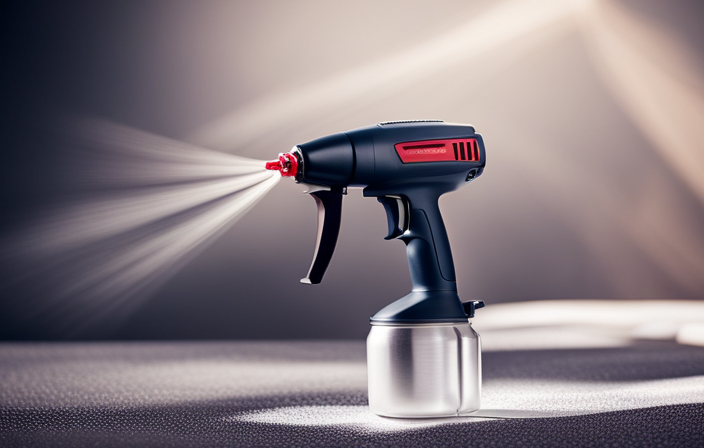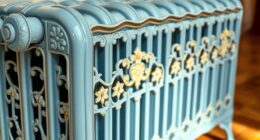Leaving paint in your sprayer overnight isn’t recommended unless you take specific precautions. If you don’t clean and seal the equipment properly, the paint can dry, clogging your sprayer and damaging parts. Oil-based paints resist separation better, but water-based ones may thicken or form skin. Proper cleanup, sealing, and storage can help, but it’s best to follow maintenance tips to prevent issues—if you want to keep your sprayer in good shape, there’s more to contemplate.
Key Takeaways
- Oil-based paints resist separation and can often be left in the sprayer overnight if properly sealed and cleaned.
- Water-based (latex) paints should be thoroughly stirred and sealed tightly to prevent skin formation and thickening.
- Leaving paint in the sprayer risks drying, clogging, and potential damage to internal components if not cleaned promptly.
- Proper cleaning and storage, including flushing and sealing, can sometimes allow for overnight reuse without issues.
- For best results, disassemble and clean the sprayer after each use, especially if you plan to leave paint in it overnight.
Factors Influencing Paint Storage in a Sprayer Overnight
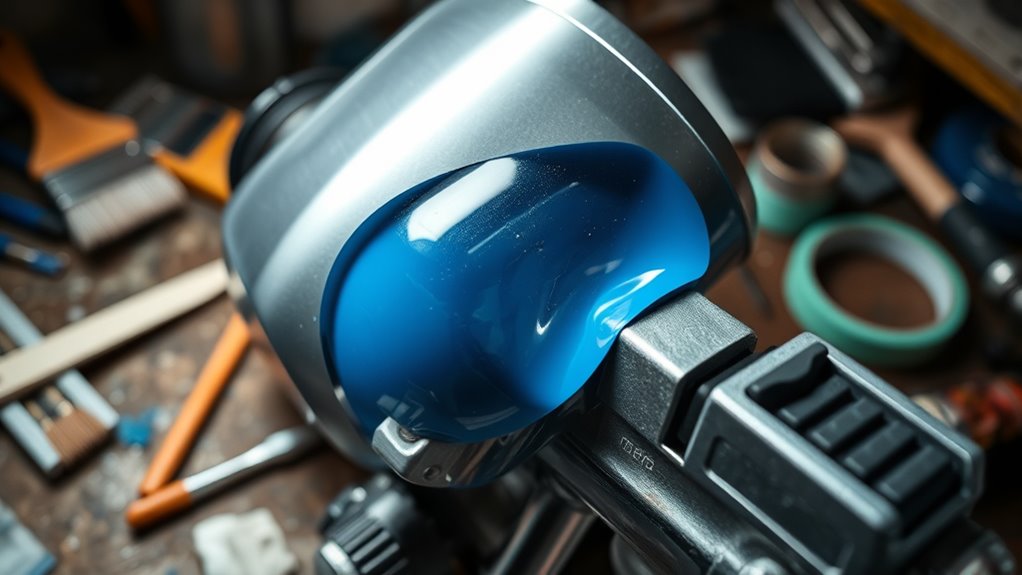
When storing paint in a sprayer overnight, several factors can affect the paint’s quality and readiness for the next use. Key among these is paint viscosity; if it thickens or separates, it may clog your sprayer or require remixing. Storage temperature also plays a crucial role—extreme cold can cause the paint to thicken, while excessive heat may lead to spoilage or separation. Maintaining a consistent, moderate temperature helps preserve the paint’s proper consistency. Additionally, exposure to air and light can cause drying or oxidation, so sealing the container tightly is essential. Monitoring these factors ensures your paint remains workable and ready for the next day’s project, reducing waste and avoiding unnecessary cleanup. Proper storage conditions are vital for maintaining optimal paint quality overnight. Understanding the importance of environmental factors can help you better preserve your paint and ensure it stays usable. Furthermore, inspecting the paint before reuse can prevent issues caused by improper storage, saving time and effort.
Types of Paint and Their Compatibility With Extended Storage
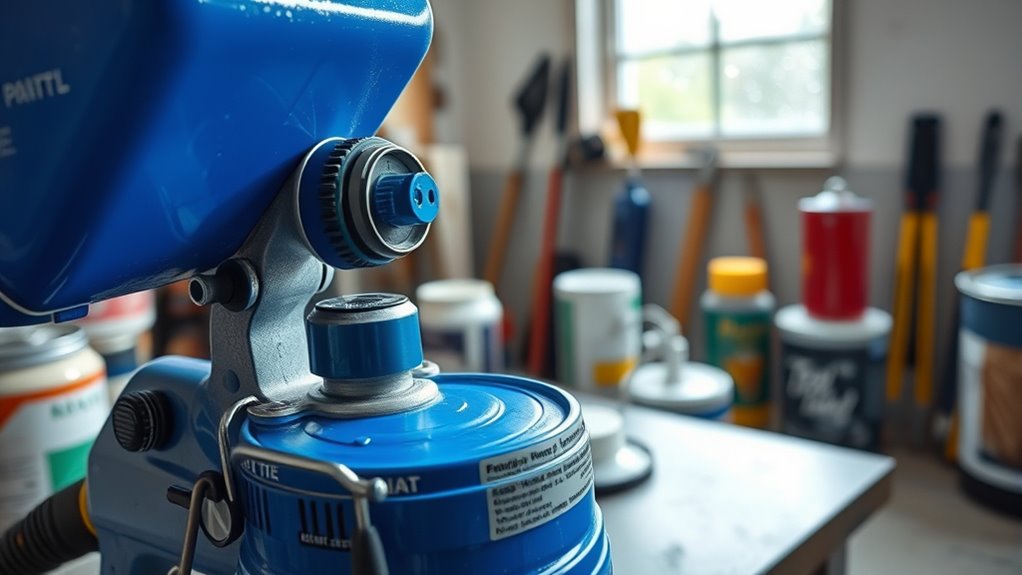
Different types of paint react differently to extended storage in a sprayer. Oil-based paints tend to last longer without separation, while water-based options like latex may need extra care. Understanding their durability helps you choose the right paint for overnight storage. Additionally, knowing the role of quality paint can influence how well the paint holds up during extended storage periods. The chemical composition of the paint also determines its stability over time when left in a sprayer.
Oil-Based vs. Water-Based
Oil-based and water-based paints each have distinct properties that affect their suitability for extended storage. Oil-based paints tend to last longer and resist separation, making them better for storing overnight. They also maintain good paint adhesion and color matching over time, but require solvents for cleanup. Water-based paints dry faster, are easier to clean, and are less odoriferous, but they may separate or thicken if left too long.
Consider these points:
- Oil-based paints generally store better without separation.
- Water-based paints may need thorough stirring before reuse.
- Extended storage can impact paint adhesion and color consistency.
- Proper sealing is essential for both types to prevent drying out.
Knowing these differences helps you decide if leaving paint overnight is feasible without compromising quality.
Latex and Enamel Durability
Latex and enamel paints vary considerably in how well they withstand extended storage, influencing your decision to leave them overnight. Latex paint generally forms a flexible paint film that can remain stable if properly sealed, but prolonged storage may affect its color stability, causing fading or discoloration over time. Enamel paints, known for durability, tend to maintain their paint film integrity better, but they can still experience issues like thickening or skin formation without proper sealing. If you plan to leave paint in your sprayer overnight, consider how each type reacts to extended storage. Latex may require more careful sealing to preserve its color stability, while enamel’s durability offers a slight advantage in maintaining quality. Properly sealing your container is essential regardless of paint type, and using the right storage method can help prevent clogging or drying out of the paint in the sprayer. Additionally, understanding the trustworthiness and vulnerabilities of AI tools can assist in optimizing your DIY projects with digital help, ensuring reliable guidance and safety. Recognizing the weight of wind turbine blades can also inform the proper handling and storage of equipment and materials used in your projects. Being aware of local regulations and market trends might also influence your choice of paint and storage practices, especially if working on larger or more complex projects.
Risks of Leaving Paint in Your Sprayer Unattended

Leaving paint in your sprayer overnight can lead to drying and curing inside the equipment, making cleanup harder later. It also increases the risk of clogs and blockages that can damage your sprayer’s components. Additionally, the paint’s composition may change over time, affecting how it sprays or bonds during your next use. Being aware of paint chemical stability can help you manage frustration if you encounter issues with your sprayer after neglecting proper cleaning. Proper maintenance and cleaning practices are essential for preserving your equipment’s longevity and performance. Neglecting these steps can also lead to buildup that affects sprayer efficiency and overall operation.
Paint Drying and Curing
If paint is left in your sprayer overnight, it can start to dry and cure inside the equipment, increasing the risk of clogs and damage. Once the paint begins to cure, it becomes difficult to clean and may affect the spray pattern or paint color accuracy during your next project. This process can also compromise sprayer maintenance, making it harder to ensure your equipment stays in good condition. To prevent issues, always clean your sprayer thoroughly after use, especially if you plan to leave it overnight. Ignoring this step allows the paint to harden, reducing efficiency and potentially damaging internal parts. Proper sprayer maintenance helps preserve the lifespan of your equipment and guarantees smooth operation for future projects. Additionally, leaving paint inside can lead to clogged nozzles, which can be costly and time-consuming to repair. Using proper storage practices and ensuring the sprayer is completely clean before storage are essential for maintaining paint consistency, which can be affected by residual paint drying inside the equipment. Ensuring your sprayer is well-maintained and properly stored is vital for optimal spraying performance, especially when working on multiple projects.
Clogging and Blockages Risk
When paint begins to dry and cure inside your sprayer, it’s only a matter of time before clogs develop. Thick or poorly mixed paint can quickly cause blockages, especially if the paint’s consistency isn’t suited for your sprayer. Leaving paint in the tank overnight increases the risk of it drying or settling, which can lead to stubborn clogs that are hard to clear. Additionally, not all sprayers are compatible with every type of paint; some materials are more prone to drying out or forming blockages. If you leave paint sitting, you might find yourself facing lengthy clean-up or even needing to replace parts. Proper Kia Tuning techniques emphasize the importance of cleaning equipment thoroughly after each use to maintain optimal performance. To avoid these issues, it’s best to clean your sprayer thoroughly after each use or use compatible paints that won’t dry out quickly, since paint drying can be accelerated by environmental factors like temperature and humidity. Regular maintenance and understanding paint compatibility can significantly reduce the risk of clogs and prolong your equipment’s lifespan. Moreover, storing your sprayer properly and ensuring it remains free of residual paint minimizes clogging risks, since residual paint buildup can cause ongoing problems and damage. This approach helps your tools stay in good working order.
Paint Composition Changes
Paint in your sprayer can undergo chemical changes if left unattended for too long, especially overnight. These changes can alter the paint’s composition, affecting its performance and safety. As the paint sits, it may develop a stronger odor, indicating chemical reactions or mold growth. Over time, the shelf life of the paint decreases, making it less effective or unusable. This can lead to clogs or uneven application later. Additionally, the solvents and additives in the paint can settle or separate, requiring thorough mixing before reuse. Leaving paint in your sprayer risks not only waste but also potential health hazards if fumes intensify or become toxic. To preserve quality, it’s best to clean your sprayer after each use and avoid overnight storage.
Proper Cleaning Procedures Before Storage
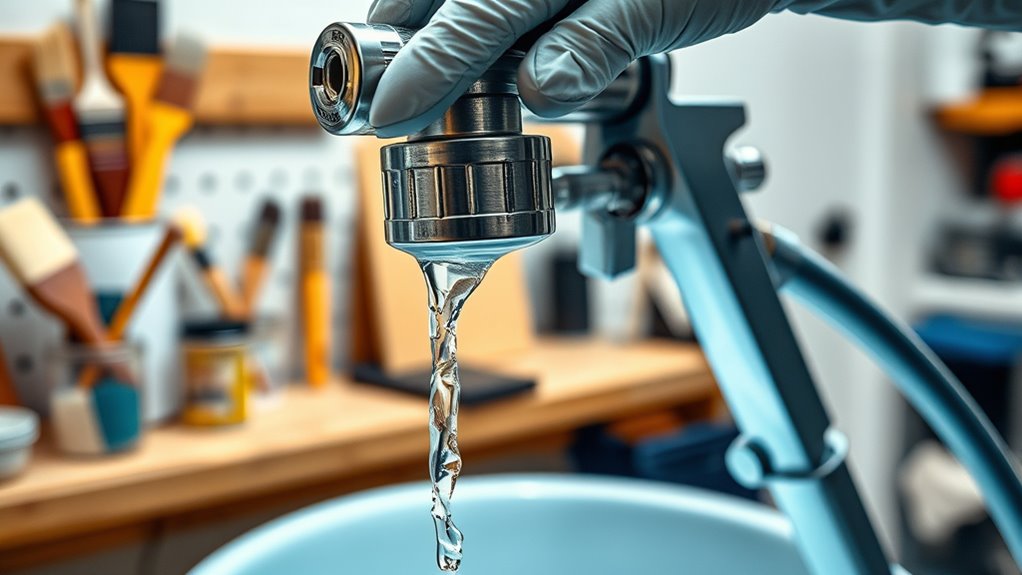
Before storing your sprayer overnight, it’s essential to thoroughly clean all components to prevent paint from drying and clogging the system. Start with brush cleaning to remove residual paint and ensure smooth operation later. If needed, thin the remaining paint with appropriate paint thinning agents to maintain its consistency. Use the table below to guide your cleaning process:
| Step | Action | Focus Area |
|---|---|---|
| 1 | Flush with solvent or water | Spray wand and nozzle |
| 2 | Wipe components thoroughly | Cup and gun parts |
| 3 | Clean the filter | Air passages |
| 4 | Brush cleaning as needed | Internal parts |
| 5 | Store dry and clean | Equipment exterior |
Following these steps helps prevent clogs and keeps your sprayer ready for the next use. Proper cleaning also helps maintain the functionality of your equipment over time, especially considering the importance of preventative maintenance to ensure longevity.
How to Prevent Clogging and Air Drying
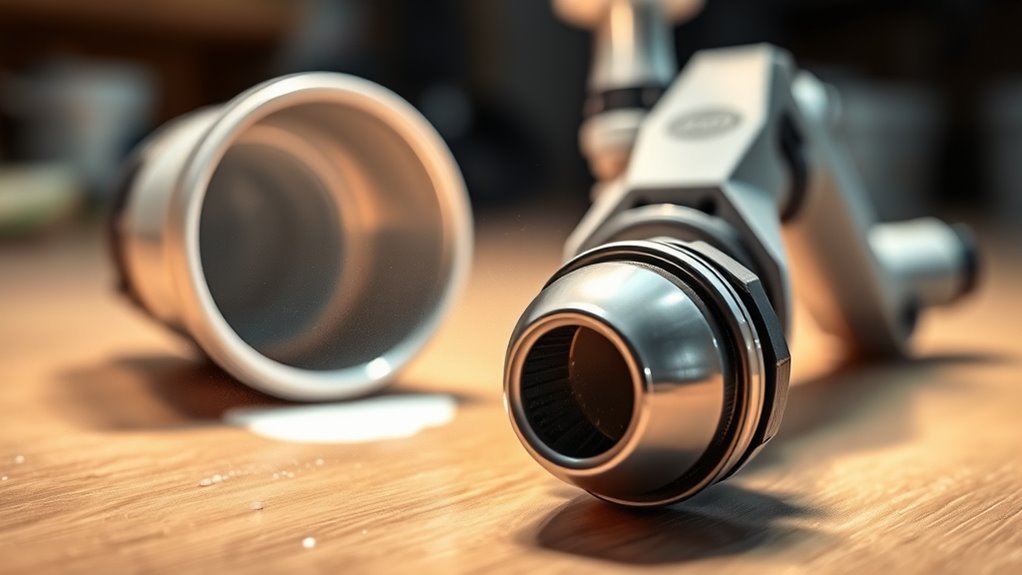
To prevent your sprayer from clogging or air drying, you need to use proper cleaning techniques immediately after painting. Applying sealants correctly can also keep paint fresh and reduce buildup inside the equipment. Additionally, storing your sprayer in ideal conditions helps prevent air from drying out the paint and causing blockages.
Proper Cleaning Techniques
Proper cleaning techniques are essential to prevent clogging and air drying inside your sprayer. To keep your equipment in top shape, start by emptying the paint container and rinsing it thoroughly with water or solvent, depending on the paint type. Next, detach the spray nozzle and clean it carefully to remove any residual paint that could cause blockages. Always flush the spray wand and other removable parts to ensure no paint dries inside. Be sure to use appropriate brushes or cleaning tools to reach tight spots. Properly drying all parts before storage minimizes the risk of clogs and buildup.
- Use the right solvent for cleaning
- Disassemble and clean all parts thoroughly
- Avoid leaving paint in the container overnight
- Check and clear the spray nozzle regularly
Using Sealants Effectively
Using sealants effectively is key to preventing clogs and air drying inside your sprayer. Always flush your spray tip thoroughly after use, ensuring no residual paint dries and blocks the nozzle. Regular brush maintenance helps keep seals flexible and effective, reducing the risk of buildup. Before sealing, verify the compatibility of the sealant with your sprayer to avoid damage. Use the following table to guide your process:
| Step | Action |
|---|---|
| 1 | Clean spray tip immediately after use |
| 2 | Apply sealant to seals and gaskets regularly |
| 3 | Store with protective covers to prevent air drying |
Consistent spray tip cleaning and proper sealant application keep your sprayer running smoothly, minimizing clogs and extending its lifespan.
Optimal Storage Conditions
Storing your sprayer correctly after use is essential to prevent clogging and air drying. Maintaining proper storage conditions helps extend the paint’s shelf life and keeps your equipment ready for next time. To avoid issues, keep your sprayer in a controlled environment with a stable storage temperature, ideally between 50-70°F. Avoid extreme heat or cold, which can cause the paint to dry out or clog the nozzle. Also, clean the sprayer thoroughly before storage, and consider using a preservative if you plan to leave paint in it overnight. Proper storage reduces the risk of dried paint inside the nozzle or hose, saving you time and effort later.
- Store in a cool, dry place
- Keep the lid tightly sealed
- Avoid temperature fluctuations
- Use additives to extend paint shelf life
Using Additives to Extend Paint Shelf Life
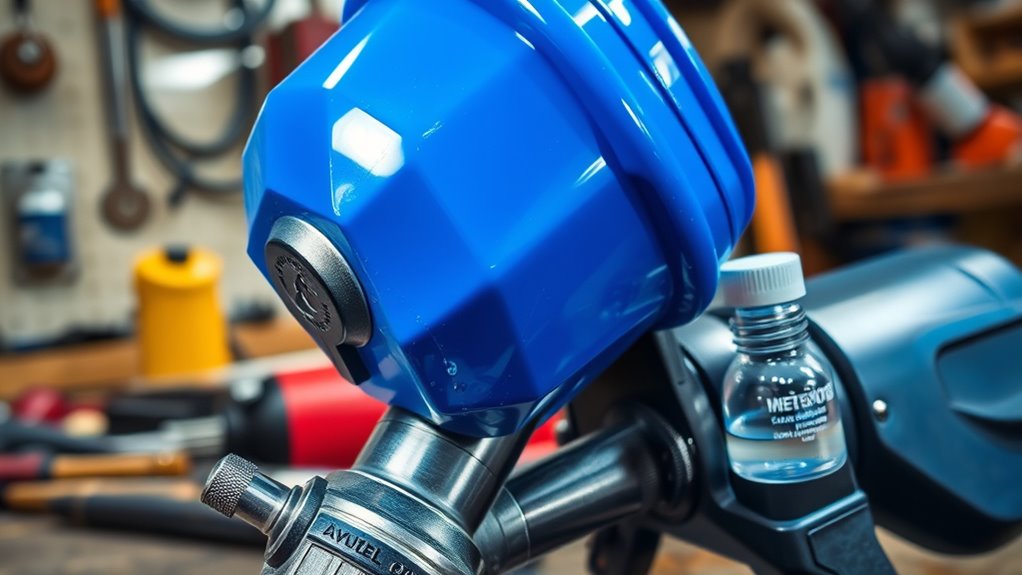
Adding special additives to your paint can considerably extend its shelf life, preventing spoilage and maintaining quality over time. Paint additives, such as preservatives and stabilizers, help inhibit microbial growth and oxidation, keeping your paint usable longer. These additives are especially useful if you plan to store paint for an extended period or leave it in your sprayer overnight. They effectively slow down the natural breakdown process, ensuring your paint remains workable and consistent when you’re ready to use it again.
| Additive Type | Benefit |
|---|---|
| Preservatives | Prevent microbial growth |
| Stabilizers | Maintain consistency and quality |
| Antioxidants | Reduce oxidation and spoilage |
Storage Conditions That Help Maintain Paint Quality
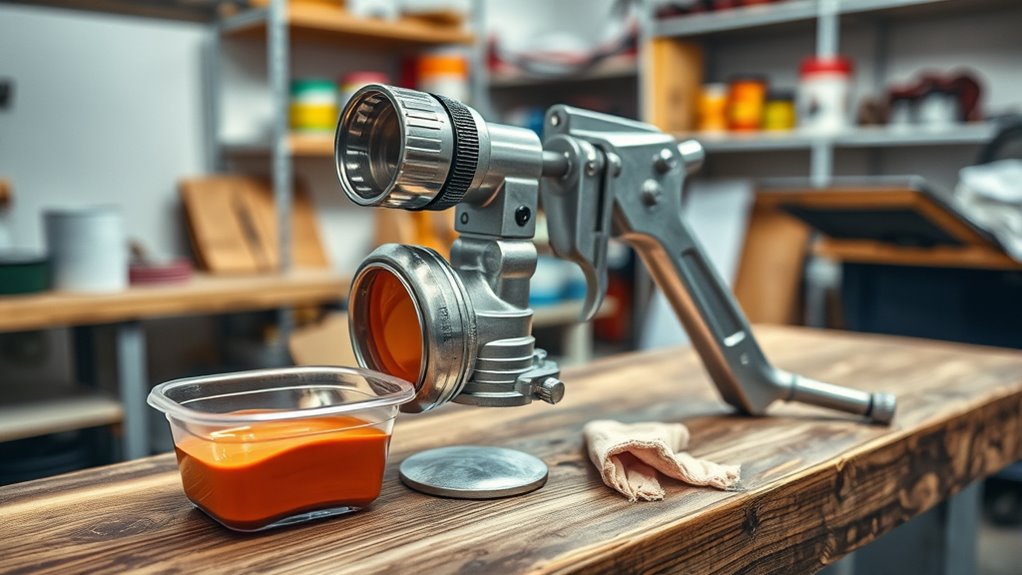
Proper storage conditions are key to keeping your paint in top condition overnight and beyond. Maintaining the right environment helps preserve its paint shelf life and prevents it from drying out or spoiling. Keep your paint in a cool, stable temperature to avoid fluctuations that can cause separation or thickening. Ideally, store it in a location with a consistent temperature between 50-70°F (10-21°C). Ensure the container is sealed tightly to prevent air exposure, which accelerates spoilage. Store your paint upright to minimize leaks and contamination. Avoid areas with direct sunlight, humidity, or extreme heat, as these can degrade the paint’s quality over time. Proper storage helps guarantee your paint remains usable for future projects without compromising its effectiveness.
Special Considerations for Oil-Based vs. Water-Based Paints
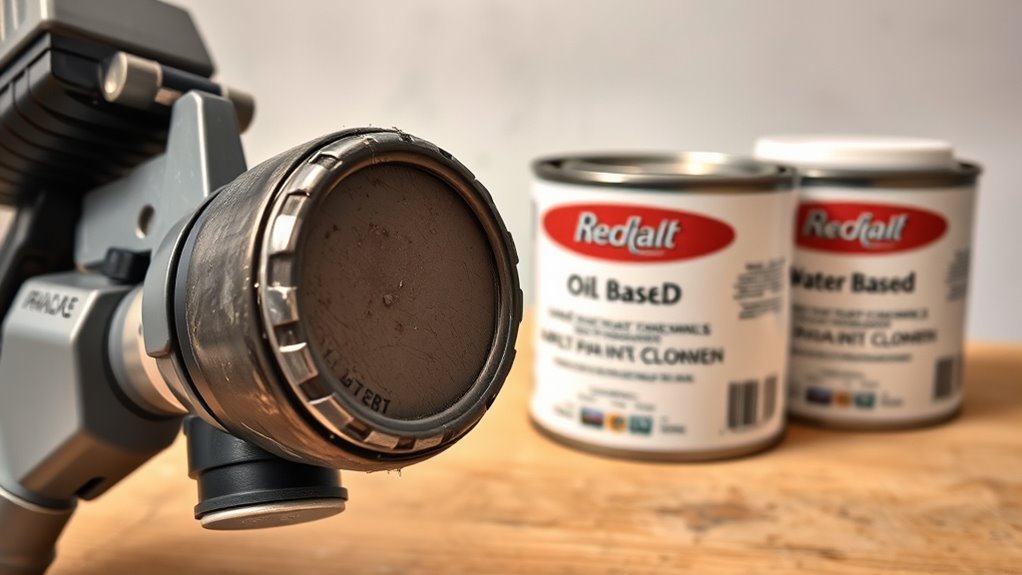
Oil-based and water-based paints require different storage considerations to maintain their quality overnight. Oil-based paints tend to thicken and may separate if left in the sprayer, so you should clean the equipment thoroughly and guarantee the paint is stored in a sealed, airtight container. Water-based paints are more prone to drying out or forming a skin, so sealing the lid tightly is vital. When it comes to paint mixing, avoid adding solvents or thinning agents unless necessary, as they can affect the paint’s consistency and performance. Proper sprayer calibration is also indispensable; if you plan to reuse the paint, verify that your sprayer settings are correct to prevent uneven application. Taking these steps helps preserve your paint’s quality and guarantees a smoother finish the next day.
Tips for Long-Term Storage of Your Sprayer and Paint

To guarantee your sprayer and paint stay in top condition during long-term storage, you should clean all components thoroughly and let them dry completely before putting them away. Proper storage prevents clogs, paint degradation, and equipment damage. Keep the paint container sealed tightly to prevent contamination and drying out. Store your sprayer and paint in a cool, dry place with a stable storage temperature—avoiding extreme heat or cold—that can cause paint separation or equipment issues. Label the paint container for easy identification later. Regularly inspect stored items for signs of wear or dried paint buildup, and consider using protective covers for added safety. Proper storage ensures your sprayer remains ready for use and your paint stays fresh for future projects.
When to Disassemble and Properly Dispose of Leftover Paint

Knowing when to disassemble your sprayer and dispose of leftover paint is essential to maintaining safe and efficient equipment. If paint begins to evaporate markedly, it can thicken or harden inside the sprayer, risking sprayer corrosion. Disassemble the sprayer when leftover paint is no longer usable, or if the paint has dried or thickened beyond easy cleanup. Proper disposal prevents environmental harm and equipment damage. Use the table below to identify key signs for disassembly and disposal:
| Indicator | Action | Reason |
|---|---|---|
| Paint evaporation | Disassemble if paint thickens | Prevents clogging and corrosion |
| Hardening or drying paint | Dispose immediately | Avoids sprayer damage |
| Inability to clean components | Disassemble and clean thoroughly | Prevents corrosion |
| Remaining paint in sprayer | Use or dispose promptly | Maintains equipment health |
| Paint smell or fumes | Disassemble and ventilate | Ensures safety |
Frequently Asked Questions
Can Leaving Paint in the Sprayer Overnight Cause Damage to the Equipment?
Leaving paint in your sprayer overnight can cause issues, especially with paint residue hardening or drying inside. This buildup can lead to equipment corrosion over time, damaging your sprayer. To avoid this, clean your equipment thoroughly after use. Proper maintenance prevents paint residue from hardening and protects your sprayer from corrosion, ensuring it stays in good condition and ready for next time.
Does the Type of Sprayer Affect Whether Paint Can Be Left Overnight?
Ever wondered if your sprayer type matters for overnight paint storage? It definitely does. Different sprayers require specific maintenance routines, and paint compatibility varies. For example, airless sprayers can often handle leftover paint better than HVLP models. To prevent clogs or damage, check your sprayer’s manual and clean it thoroughly if you plan to leave paint overnight. Proper sprayer upkeep ensures your equipment stays in top shape and ready for your next project.
Are There Specific Brands of Paint That Are Better for Overnight Storage?
When choosing paint for overnight storage, look for brands that include paint additives to keep the paint from drying out. Opt for high-quality storage containers that seal tightly to prevent air exposure. Brands like Sherwin-Williams or Benjamin Moore often have paints with better formulation for long-term storage. Always clean your sprayer thoroughly before storing, and use appropriate additives if recommended, ensuring your paint stays fresh and usable when you return.
How Does Ambient Temperature Impact Overnight Paint Storage in a Sprayer?
When it comes to overnight paint storage, you’re playing with fire if the temperature swings wildly. Temperature effects can cause your paint to thicken or become too runny, messing with the paint consistency. Keep your sprayer in a stable, moderate environment to prevent clogs or separation. A consistent temperature guarantees your paint stays usable, so don’t let those temperature fluctuations throw a wrench in your project plans.
Is It Safe to Reuse Paint Left in the Sprayer After Overnight Storage?
You can often reuse paint left in your sprayer after overnight storage, but it depends on how well you’ve maintained it. First, do paint cleanup properly to prevent clogs, and then check the paint’s consistency before reuse. Good sprayer maintenance, like cleaning the nozzle and reservoir thoroughly, ensures the paint doesn’t dry or thicken, making it easier to work with next time. Always inspect for contamination or skin formation before reuse.
Conclusion
Ultimately, whether you can leave paint in your sprayer overnight depends on the type of paint and how well you prep the equipment. With a bit of luck and proper cleaning, you might save time and avoid waste. Just remember, even a small oversight can lead to clogs or dried paint that ruins your next project. Sometimes, the best results come from a little extra effort—turning a routine task into a stroke of accidental brilliance.
